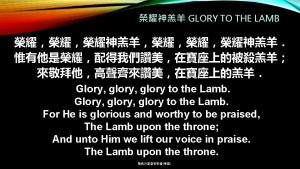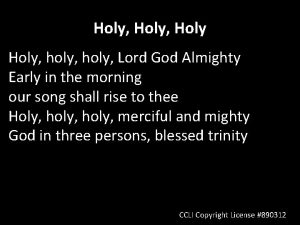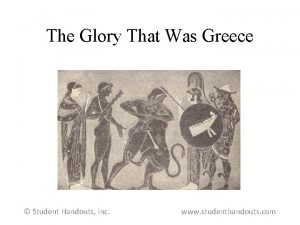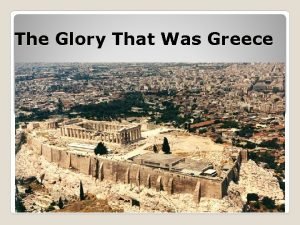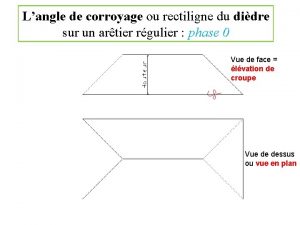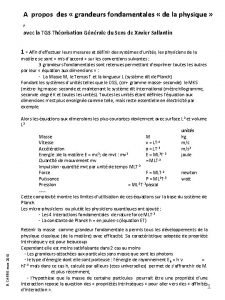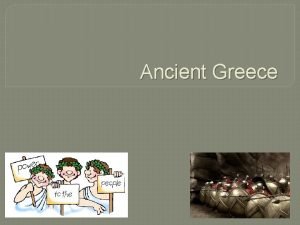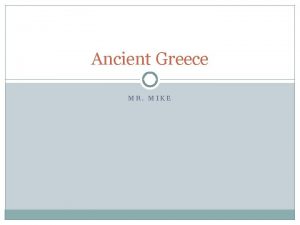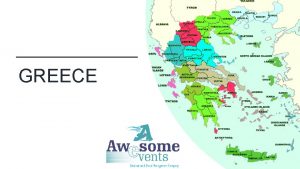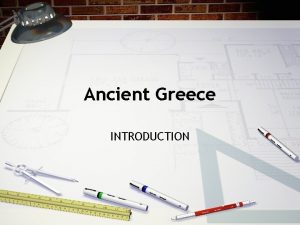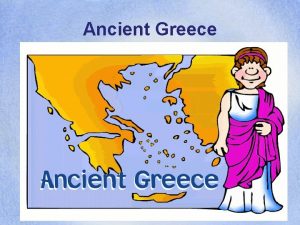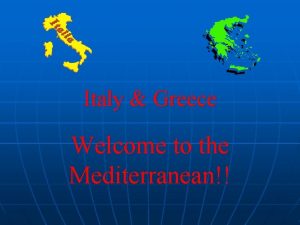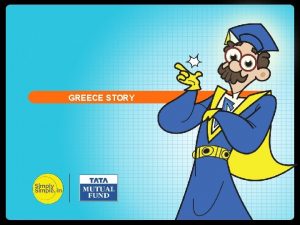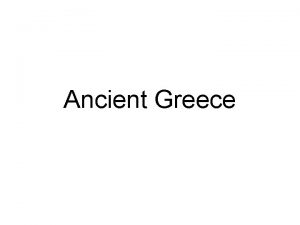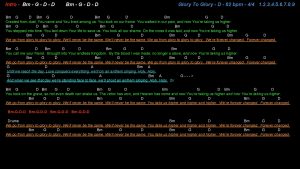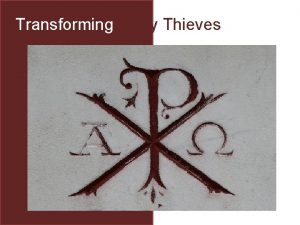The Glory That was Greece The Grandeur That
























- Slides: 24

The Glory That was Greece & The Grandeur That was Rome Daily Life in Ancient Rome w/ Mr. C

Overview of Roman History � Ancient Rome was at first a small agricultural community founded circa the 8 th century BC (700’s) that grew over the course of the centuries into a colossal empire encompassing the whole Mediterranean Sea, in which Ancient Greek and Roman cultures merged into one civilization. This civilization was so influential that parts of it survive in modern law, administration, philosophy and arts, forming the ground that Western civilization is based upon. � In its twelve-century existence it transformed itself from monarchy to republic and finally to autocracy. In steady decline since the 2 nd century AD, the empire finally broke into two parts in 285 AD: the Western Roman Empire and the Byzantine Empire in the East. The western part under the pressure of Goths finally dissolved, leaving the Italian peninsula divided into small independent kingdoms and feuding city states for the next 14 centuries, and leaving the eastern part sole heir to the Roman legacy.

The End �We will have our final in 5 minutes. �Questions?


Why study Rome? “The Romans knew how to govern people, establish legal structures and construct roads that took them to the ends of their known world”


Geography. Locus-Locus � Middle of the Mediterranean � Larger and more arable land than Greece- mts north and south � River valleys- Po in the North, Tiber in middle of boot � Rome - inland accessible by boat- defensible, on “Seven Hills” � Capitoline � Quirinal � Viminal � Esquilin � Cælian (Coelian/Celio) � Aventine � Palatine

The 7 Hills of Rome



Origins of Rome �Legend: Romulus and Remus raised by shewolf 733 BC traced boundaries with plow �Later: Virgil’s Aeneus, hero of Troy, roams the Med looking for a home �Reality: Etruscans �unsure of origin �used iron, bronze and silver �Rome and Latins under rule of king �beginning fear of kings, rebelled �invaded by Gaul 390 BC

Boring! � Let’s look at the real origins of Rome. � Romulus and Remus were twin brothers. � The grandfather and great-uncle of the � � � twins were Numitor and Amulius seized Numitor's share and became sole ruler. Rhea Silvia (also called Ilia) made a vestial virgin. Since vestal virgins could be buried alive if they violated their chastity vows, whoever forced Rhea Silvia to enter the equivalent of an ancient convent assumed that Rhea Silvia would remain childless. Amulius had a swineherd, Faustulus, leave the twins on the river bank to die. BUT a she-wolf nursed them, and a woodpecker fed and guarded them

Or maybe… �The Trojan prince Aeneas, an important figure linking the Romans with the Trojans and the goddess Venus, escaped from Troy with his son in his arms and carrying his father on his back. He led his men to Africa, Sicily and finally Etruia. Setting up a kingdom in Alba Longa.

Kidding. This is Barocci’s version.

Who were the Etruscans?

Who were the Etruscans? �The Etruscans, who lived in Etruria, were known as Tyrrhenians by the Greeks. They were at their height in Italy from the 8 th to the 5 th century B. C. �They inhabited the triangular area between the Mediterranean Sea and the rivers Arno and Tiber in central Italy. �Herodotus says the Etruscans came from Lydia, in Asia Minor, as the result of a famine around 1200 B. C. , like the Irish coming to the U. S. as a result of a potato famine in the 19 th century. �(This one has DNA evidence!)

Who were the Etruscans? �Etruscans built such cities as Tarquinii, Vulci, Caere, and Veii. �Etruscan homes were mud-brick, with timber on stone foundations, some with upper stories. �But their temples…

Etruscan Temples

Etruscan Temples �An Etruscan temple, to meet religious requirements, was located on a north-south axis and stood on a high podium with a fourcolumned porch in front of three doors leading to three parallel rooms for the three chief Etruscan gods. �The brilliantly painted terracotta statuary that decorated the roof along the eaves, ridge pole, and at the gable ends also served the practical purpose of hiding and protecting tile joints and rafter ends. Plaques with low-relief figures adorned the entablature.

Etruscan Culture �Pairing: Husband & Wife �Etruscan state government was essentially a theocracy. Etruscans was vertical, or generational. They kept �The political unit of track of six generations. Etruscan society was the city-state. �The names of persons are generally binomial: Vethur Hathisna, Avile Repesuna, Fasti Aneina. �Kinship among the

Etruscan Gods & Goddesses �Catha and Usil, the sun �Tivr, the moon �Selvan, a civil god �Turan, the goddess of love �Laran, the god of war �Leinth, the goddess of death �Maris, Thalna, Turms and the ever-popular Fufluns �The Etruscans believed in intimate contact with divinity. �They did nothing without proper consultation with the gods and signs from them. � Augery � Auspices

What do the Romans… � ADOPT � The power of religion and mysticism. The Etruscans were profoundly and eternally influenced by mysticism and what we would generally refer to as "superstition". � REJECT � The position of women in Etruscan society. As opposed to Roman and Greek societies, Etruscan women sat with their husbands at banquets, had their own personal possessions and were actively involved in day to day politics. From the point of view of Roman morality Etruscan women were immoral and dissolute.

The Last of the Kings � Tarquinius Priscus. —The first of these new kings, it is said, came from the Etruscan city of Tarquinii, from which he derived his name. The story is told that, as he approached the city, an eagle came from the sky, and, lifting his cap from his head, replaced it. His wife, who was skilled in the Etruscan art of augury, regarded the eagle as a messenger from heaven, and its act as a sign that her husband was to acquire honor and power � Servius Tullius. —The next king was Servius Tullius, who is said to have been the son of a slave in the royal household, and whom the gods favored by mysterious signs. � Tarquinius Superbus. — Tradition represents the last king, Tarquinius Superbus, as a cruel despot. He obtained the throne by murder, and ruled without the consent of the senate or the people. He loved power and pomp.

Formation of the Republic �Next time
 Glory that was greece grandeur that was rome
Glory that was greece grandeur that was rome Glory glory glory to the lamb
Glory glory glory to the lamb Glory glory hallelujah he reigns
Glory glory hallelujah he reigns Hymn 647
Hymn 647 Glory glory oh god almighty
Glory glory oh god almighty Glory glory how the angels sing
Glory glory how the angels sing The glory that was greece answers
The glory that was greece answers The glory that was greece
The glory that was greece Art that recaptures greco-roman grace and grandeur
Art that recaptures greco-roman grace and grandeur Rectiligne du diedre
Rectiligne du diedre Na nombre d'avogadro
Na nombre d'avogadro Les grandeurs fondamentales
Les grandeurs fondamentales Warrior art and narration in stone relief.
Warrior art and narration in stone relief. Pression grandeur scalaire ou vectorielle
Pression grandeur scalaire ou vectorielle Tìm độ lớn thật của tam giác abc
Tìm độ lớn thật của tam giác abc Sau thất bại ở hồ điển triệt
Sau thất bại ở hồ điển triệt Thể thơ truyền thống
Thể thơ truyền thống Con hãy đưa tay khi thấy người vấp ngã
Con hãy đưa tay khi thấy người vấp ngã Thơ thất ngôn tứ tuyệt đường luật
Thơ thất ngôn tứ tuyệt đường luật Tôn thất thuyết là ai
Tôn thất thuyết là ai Phân độ lown ngoại tâm thu
Phân độ lown ngoại tâm thu Chiến lược kinh doanh quốc tế của walmart
Chiến lược kinh doanh quốc tế của walmart Gây tê cơ vuông thắt lưng
Gây tê cơ vuông thắt lưng Block xoang nhĩ độ 2 type 1
Block xoang nhĩ độ 2 type 1 Hổ đẻ mỗi lứa mấy con
Hổ đẻ mỗi lứa mấy con

